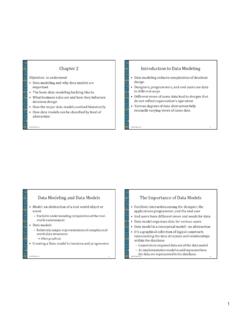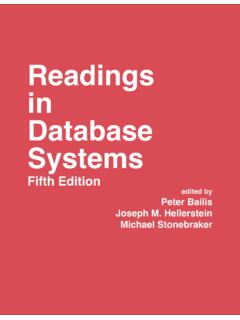Transcription of Chapter 1 Introduction
1 1 Chapter 1 Objectives: to learn The difference between data and information What a database is, the various types of databases, and why they are valuable assets for decision making The importance of database design How modern databases evolved from file systems About flaws in file system data management The main components of the database system The main functions of a database management system (DBMS)1CS275 Fall 2010 Introduction Good decisions require good information derived from raw facts Data is managed more efficiently when stored in a database Databases solve many of the problems encountered in data management Used in most modern settings involving data : Business, Research, Administration Important to understand how databases work and interact with other applications Data Management: the discipline of generating, storing, & retrieving data A Core activity of any organization2CS275 Fall 2010 Data vs.
2 Information Dataare raw facts Informationis the result of processing raw data to reveal meaning Information requires context to reveal meaning Raw data must be formatted for storage, processing, and presentation Data: building blocks of information Information produced by processing data Information used to reveal meaning in data Accurate, relevant, timely information is the key to good decision making Good decision making is the key to organizational survival3CS275 Fall 2010 Introducing the Database Database: shared, integrated computer structure that stores a collection of: End-user data: raw facts of interest to end user Metadata: data about data Provides description of data characteristics and relationships in data Complements and expands value of data Database management system (DBMS): collection of programs Manages structure and controls access to data4CS275 Fall 20102 Role and Advantages of the DBMS DBMS is the intermediary between the user and the database Database structure stored as file collection Can only access files through the DBMS DBMS enables data to be shared DBMS integrates many users views of the data5CS275 Fall 2010 Role and Advantages of the DBMS Advantages of a DBMS.
3 Improved data sharing Improved data security Better data integration Minimized data inconsistency Results in: Improved data access Improved decision making Increased end-user productivity as it Promotes integrated view of organization s operations Reduces the probability of data inconsistency enables producing quick answers to ad hoc queries6CS275 Fall 2010 Types of Databases Databasescan be classified according to:1. Number of users2. Database location(s)3. Expected type and extent of use Single-user database supports only one user at a time Desktop database: single-user; runs on PC Multiuser database supports multiple users at the same time Workgroup Enterprise7CS275 Fall 2010 Types of Databases Centralized database: data located at one site Distributed database: data distributed across several different sites Operational database: supports a company s day-to-day operations Transactional or production database Data warehouse.
4 Stores data used for tactical or strategic decisions8CS275 Fall 20103 Types of Data in Databases Unstructured data exist in their original state Structured data result from formatting Structure applied based on type of processing to be performed Semistructured data have been processed to some extent Extensible Markup language (XML) represents data elements in textual format XML database supports semistructuredXML data9CS275 Fall 2010 Why Database Design Is Important Database design focuses on design of database structure used for end-user data Designer must identify database s expected use Well-designed database: Facilitates data management Generates accurate and valuable information Poorly designed database: Causes difficult-to-trace errors Ultimately can lead to poor decisions and failure of an Fall 2010 Evolution of File Systems Reasons for studying file systems.
5 Complexity of database design is easier to understand Understanding file system problems helps to avoid problems with DBMS systems Knowledge of file system is useful for converting file system to database system File systems typically composed of collection of file folders, each tagged and kept in cabinet Organized by expected use Contents of each file folder are logically related Manual systems were data repositories for small data collections & cumbersome for large collections11CS275 Fall 2010 Evolution of File Systems Computerized file systems Data processing (DP) specialist converted computer file structure from manual system Wrote software that managed the data Designed the application programs Initially, computer file systems resembled manual systems As number of files increased, file systems evolved Each file used its own application program to store, retrieve.
6 And modify data Each file was owned by individual or department that commissioned its creation12CS275 Fall 2010413CS275 Fall 2010 Basic File Terminology14CS275 Fall 2010 Problems with File Systems File systems were an improvement over manual system File systems used for more than two decades Understanding the shortcomings of file systems aids in development of modern databases Many problems not unique to file systems Even simple file system retrieval task required extensive programming Ad hoc queries impossible Changing existing structure difficult15CS275 Fall 2010 Problems with File Systems Security features difficult to program Often omitted in file system environments Summary of file system limitations: Requires extensive programming Cannot perform ad hoc queries System administration is complex and difficult Difficult to make changes to existing structures Security features are likely to be inadequate16CS275 Fall 20105 Structural and Data Dependence Structural dependence: access to a file is dependent on its own structure All file system programs must be modified to conform to a new file structure Structural independence: change file structure without affecting data access Data dependence.
7 Access to data is dependent on the data characteristics All file system programs must be modified to conform to new data characteristics Data independence: data storage characteristics do not affect data access17CS275 Fall 2010 Structural and Data Dependence Practical significance of data dependence is difference between logical and physical format Logical data format: how human views the data Physical data format: how computer must work with data Each program must contain: Lines specifying opening of specific file type Record specification Field definitions18CS275 Fall 2010 Data Redundancy File system structure makes it difficult to combine data from multiple sources Vulnerable to security breaches Organizational structure promotes storage of same data in different locations Islands of information Data stored in different locations is unlikely to be updated consistently Data redundancy: same data stored unnecessarily in different places19CS275 Fall 2010 Effects of Data Redundancy Data inconsistency.
8 Different and conflicting versions of same data occur at different places Data anomalies: abnormalities when all changes in redundant data are not made correctly Update anomalies Insertion anomalies Deletion anomalies20CS275 Fall 20106 Lack of Design and Data-Modeling Skills Most users lack the skill to properly design databases, despite multiple personal productivity tools being available Data-modeling skills are vital in the data design process Good data modeling facilitates communication between the designer, user, and the developer21CS275 Fall 2010 Database Systems Database system consists of logically related data stored in a single logical data repository May be physically distributed among multiple storage facilities DBMS eliminates most of file system s problems Current generation stores data structures, relationships between structures, and access paths Also defines, stores, and manages all access paths and components22CS275 Fall 2010 The Database System Environment Database system: defines and regulates the collection, storage, management, use of data Five major parts of a database system.
9 Hardware Software People Procedures Data23CS275 Fall 2010 The Database System Environment Hardware: all the system s physical devices Software: three types of software required: Operating system software DBMS software Application programs and utility software People: (System and database administrators, Database designers, Systems analysts and programmers, End users Procedures: instructions and rules that govern the design and use of the database system Data: the collection of facts stored in the database24CS275 Fall 20107 The Database System Environment Database systems are created and managed at different levels of complexity Database solutions must be cost-effective as well as tactically and strategically effective Database technology already in use affects selection of a database system25CS275 Fall 2010 DBMS Functions Most functions are transparent to end users Can only be achieved through the DBMS Data dictionary management DBMS stores definitions of data elements and relationships (metadata))
10 In a data dictionary DBMS looks up required data component structures and relationships Changes automatically recor

















